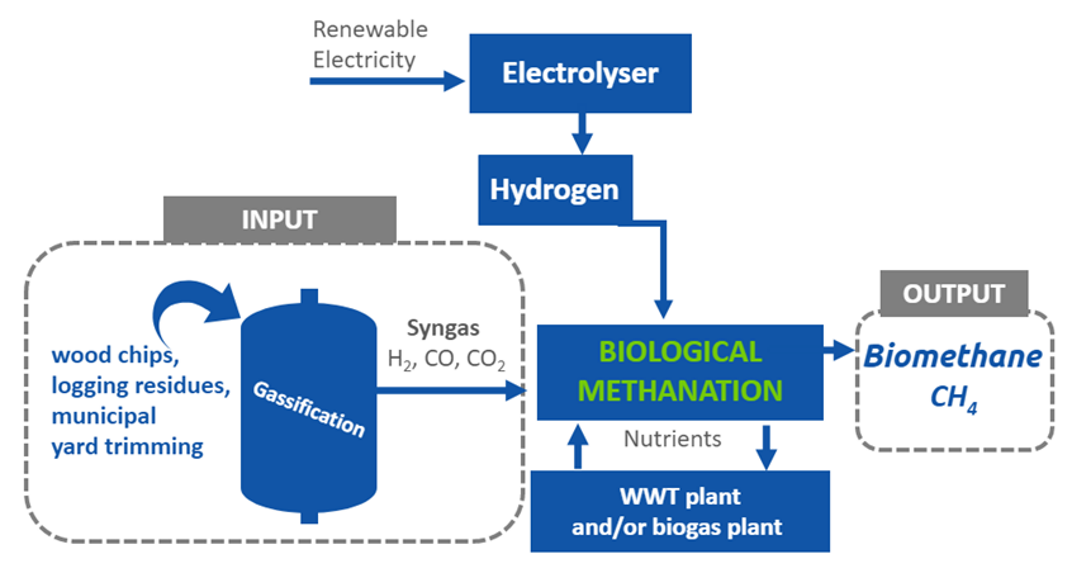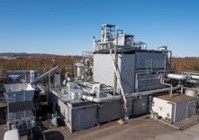Höganäs
About the site
The CORTUS demonstration site is an existing 6 MW gasification plant owned by the CORTUS company. The plant is situated in Höganäs, Region of Götaland.
The gasification technology employed is referred to as the WoodRoll® process. This involves drying, pyrolysis and gasification stages to convert raw biomass to synthesis gas (mixture of CO + H2) in CO/H2 ratio of approximately 1:2. Additionally, the gas contains CO2 (14%) and some CH4 (1%).
Current feedstock is wood chips with 40% moisture. However, the plant could run on fuel with up to 45% moisture without pre-drying which enables conversion of woody waste products such as logging residues or municipal yard-trimmings. The produced syngas is used as a green energy input for steel powder manufacturing by an adjacent industry.
The wastewater treatment plant is a standard tertiary WWTP dimensioned for 35,000 PE.
Our technology in brief
The specific type of biological methanation intended for demonstration in this case converts syngas (CO, H2, CO2 and some CH4) from thermal gasification and/or pyrolysis via biological methanation to biomethane in a Trickle Bed Reactor (TBR). This reactor is fed by syngas and a nutrient solution which can be in the form of digestate from a co-located conventional biogas plant or reject water from municipal wastewater sludge dewatering. The syngas meets a selectively adapted mixed culture biofilm on carriers and a continuous flow of nutrient rich solution. The CO and H2 are consequently converted to CH4 and CO2. The TBR design allows for a high exchange rate between the gas and liquid phase. If it is desirable to also utilize the remaining CO2 and produce a final gas mix of very high CH4 content, an additional source of H2 from an electrolyser can be added to the input syngas.
This reaction between the additional H2 and CO2 would happen in the same TBR facilitated by the same mix culture biofilm, resulting in higher utilization of invested CAPEX and the elimination of a conventional upgrading step. The demonstration plant will be equipped with a small electrolyser able to provide external H2 volumes from renewable electricity to achieve stochiometric balance for conversion of all CO2 to methane. The planned trials will demonstrate biological methanation of syngas both without and with addition of external H2.
Our ambition
The demonstration plant for this technology will be mobile: this will allow for testing and demonstration of the process at separate sites and show that the process is flexible enough to be relevant for different syngas qualities and integration options. During the BIOMETHAVERSE project, the mobile pilot will be tested at its first host gasification plant (see description of demonstration site above). Reject water from a nearby municipal wastewater treatment plant will be used as the nutrient solution. Both the host gasification plants as well as the municipal wastewater treatment plant are existing facilities in full operation. The gasification plant is WoodRoll 6 MW gasification plant from CORTUS which supplies syngas to Höganäs for the production of fossil free iron powder. The wastewater treatment plant is a standard tertiary WWTP dimensioned for 35,000 PE.
The mobile pilot plant for biological methanation of syngas will consist of a 30 ft technology container including housing, pumps, valves, controllers, heating, cooling, gas management, measurement equipment, etc. and a separate vertical TBR. The final design is yet to be determined, but the effective reactor volume will be 2-5 m3 (1-2 m diameter and 3-4 m high). The pilot plant will also include a small electrolyser for local production of additional green hydrogen, which will widen the scope of possible production conditions demonstrated. This demonstration project is a scale-up by 2-3 orders of magnitude compared to what has already been tested and will be the first of its kind globally. The ambition of this demonstration is to achieve pipeline injection specifications biomethane through biological methanation of syngas with addition of external hydrogen, but without the addition of conventional upgrading.
Our challenges
TBR is a relatively under-utilized reactor type which makes theoretical assessment of practical scale-up cost challenging since there is not much in the real world to compare with. The concept is dependent on both a local source of syngas and on a nutrient solution. During the BIOMETHAVERSE project there will be need to identify possible edge effects at scale to enable properly designing a full-scale plant.



